England (Summer 2003)
Wednesday, August 13
After a long but uneventful flight from California to England, I emerge from Heathrow Airport's International Arrivals area to find my friend Karen, who has flown from Ontario (Canada), waiting as planned. So far, so good. After taking a few minutes to figure out how to put the rental car in reverse (pull up on the gearshift), we are on our way to London. I am the navigator; Karen is the driver. I am not too proud to admit I am terrified to drive in this country—for goodness' sake, they drive on the wrong side of the road! But I'm very good with a map, and Karen is a fearless driver.
We arrive at our hotel and go up separately to the lobby, since the
building dates from 1850 and only one person at a time will fit in the
elevator, which makes a phone booth look roomy. Karen remarks that now she
knows what her coffin will feel like. Happily, we find we've been upgraded
to a suite—the Greville Janner suite, which, not having a clue who
Greville Janner is (was?), we can only remember as the Bruce Jenner suite.
Luckily, there is a sign in the lobby pointing to the suite, so every time
we need to ask for the key, we can glance at the sign and say the name
correctly. This suite is so crammed (make that charmingly cluttered
)
with furniture we can barely get our luggage through the living room part
and into the bedroom. But we have a skylight in the living room and a tiny
balcony (overlooking the parking lot) and two television sets (which we
will never turn on). Most importantly, given the current, record-breaking
heat wave, we have air-conditioning.
We have an hour to wait before some friends arrive, so we set the
air-conditioning to freeze
and leave to take a stroll in Hyde Park
(across the street), which is sadly browned by the current high
temperatures and lack of rain (not that I mind the lack of rain, mind you).
After leaving the park, we look around for shops (what can I
say…we're two women!), but alas, there are none in the vicinity.
Andrew and Libby arrive, and we take the Underground (London's subway
system, also known as the Tube
) to have dinner at Brown's. Then
we're off to Holborn station, where we're to meet the guide for a London
Walk entitled Ghosts, Gaslight & Guinness.
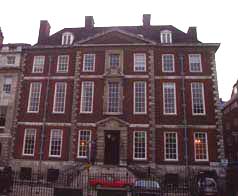 This house in Lincoln's Inn Fields will be used in my next book.
This house in Lincoln's Inn Fields will be used in my next book.
We're half an hour early, so we walk to nearby Lincoln's Inn Fields, where my Chase family (from Amethyst, Emerald, Amber, and Violet) has a town house and I hope to find another house for the new book I am writing. The perfect house is awaiting us, built in 1686 (the story takes place in 1689). We just have time to snap pictures and make some notes before our tour will begin.
Our tour guide is Richard III, billed as an actor, director, writer,
stand-up comic, and the only London Walks guide to have addressed the
United Nations.
He tells several intriguing ghost stories while
frog-marching us though the city for two hours. Karen complains the entire
time, but since I've spent the last three weeks tramping over the entire
east coast of the United States with blisters on both feet, I'm afraid I
have little sympathy.
Speaking of feet, the tour guide tells us that in the 17th century, Lincoln's Inn Fields was lit by oil lamps filled with mutton fat, and the wicks were made of toes. Or is that tows? I can't imagine either one…must look into this further. Karen thinks the square would smell very good with all the mutton fat burning (she won't eat beef but adores lamb). Or at least she would think that if her feet weren't hurting so much.
 My villains will hang out at this pub in Covent Garden, which was
called The Lamb back in 1689.
My villains will hang out at this pub in Covent Garden, which was
called The Lamb back in 1689.
I also need to find an old tavern where my bad guys can hang out, so I'm
very happy that this tour includes Guinness
when we end up at a
great place called Nell of Old Drury, located across from the Drury Lane
Theatre. In 1689, it was known as The Lamb, and supposedly there's still a
tunnel underneath which Charles II used to leave the theater and sneak
through to meet his mistress Nell Gwyn. I probably won't be using the
tunnel in the tale, but the tavern is very atmospheric and just perfect.
More photo-snapping ensues.
After the tour, we say goodbye to Andrew and Libby and make our way home. Karen decides I made an excellent hotel choice since the Tube station is just across the street. No more walking. Jetlag is setting in.
Thursday, August 14
This morning we head to the Museum of London and spend way too much time perusing the exhibits, especially the fascinating section on Roman London, which has nothing to do with what I'm writing (except to make me want to write a book set in that era although I know it will never sell). The sections on Tudor and Stuart London are more relevant and just as interesting. Dr. Karen, a dentist, takes many pictures of early ivory dentures and rusty, torturous-looking primitive 16th and 17th century dental instruments, planning to get the photos enlarged and framed so she can use them to threaten her patients if they fail to behave.
 16th and 17th century dental instruments from the Museum of London. Karen
says one is called a
16th and 17th century dental instruments from the Museum of London. Karen
says one is called a pelicanand the others are
elevators—they were all used for extractions, since that was
the treatment of choice.
In the museum's bookstore, I am able to look up some information about the house I found in Lincoln's Inn Fields yesterday. And, of course, I buy books. I always do when I'm in the UK…collecting research books is a disease with no cure. There are so many books here that it's impossible to find at home, and I simply cannot pass up any of them.
We've stayed at the museum much longer than we'd planned. By now it is
almost one o'clock, and we've booked a Parliament tour across town at 1:15.
Needless to say, we are late. When we arrive with our tickets in hand, two
nice gentlemen ask us very politely to stand aside and wait until they can
find a tour group going through that has room for two extra people (us).
This takes them about fifteen minutes, and every two minutes they apologize
for not finding us a spot sooner. Imagine that—they are apologizing
to us when we are the ones who were late! At home, be it the USA
or Canada, tour operators would just say, You missed your tour.
Tough.
This is why we like this country. Well, that and the clotted
cream.
The Parliament building is drop-dead gorgeous, the ceilings all intricate and gilded, the floors beautifully tiled. On the House of Lords side, that is. The House of Commons has plain stone, wood, and carpet. Very interesting.
 Westminster Hall, site of William and Mary's coronation banquet.
Westminster Hall, site of William and Mary's coronation banquet.
The tour ends in Westminster Hall, both the oldest (built between 1097 and
1099) and largest room still in use in England. I'm planning to set a
scene here, so this is what I've really come to see—it's why we took
the Parliament tour, because that's the only way to see it. The chamber
doesn't disappoint. The ancient stone walls and incredible wooden
hammerbeam roof (built later,
in 1375) are even better than I'd
envisioned, and the scene comes to life in my head.
After snapping pictures and buying more books, we head across the road to Westminster Abbey. I've seen it twice before, but I have a scene planned here, too—William and Mary's coronation—plus, in honor of the 50th anniversary of Queen Elizabeth's coronation, the Abbey's museum is currently hosting a special exhibit about coronations through the ages. But it is 4:30 now, and the Abbey closed at 3:45.
Grrrr. Since when does a major tourist attraction close at 3:45???
Deciding it's just as well since we're exhausted, we head to our hotel for a short rest before Andrew and Libby arrive for dinner and another walking tour. Our rest turns out especially short when they arrive about two minutes after we do.
Dinner tonight is at a patisserie in Soho, a fun, funky area. We buy
sugar mice
before leaving—darling colored mouse-shaped sweets
that Libby assures us taste divine.
We eat them as we jostle our
way back to the Tube station through crowded Leicester Square. They taste
more or less like pure sugar.
Another friend, Jane, meets us all for tonight's walk, which is titled
Undiscovered London.
Richard III is our guide again. The walk turns
out to be two-and-a-half hours of traipsing through Southwark, a rather
unsavory area that we decide is undiscovered
because no one wants
to go there. However, there are three pub stops, so we have ample time to
rest our feet. And Andrew likes the beer.
After all that exertion we are starving again, so at 11:00 pm, we stop at a pasta and pizza place for a bite to eat. Leicester Square is teeming with people, more lively even than at 5:00 when we walked through it to get to dinner. Only in London.
Friday, August 15
Although we're still suffering the last dregs of jetlag (hey, eight hours is a big adjustment!), we get up early to be at Westminster Abbey when it opens. We weren't planning to visit this morning—we were planning to leave London directly after breakfast—but it's a good thing we do, because the coronation exhibit is wonderful.
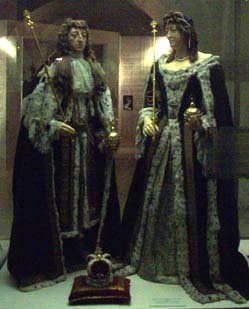 William and Mary's effigies wearing their coronation outfits. William is
standing on a box so it's not as obvious he was shorter than she was!
William and Mary's effigies wearing their coronation outfits. William is
standing on a box so it's not as obvious he was shorter than she was!
They have the actual 300-year-old wax effigies of William and Mary made right after their deaths, full-bodied statues wearing their actual coronation clothes, which have faded from what I'm sure was a rich purple to a dull gray. And there is lots of excellent information. In the Abbey itself, I am able to check out how and where the coronation was set up, which was a little different than I'd been imagining. Very constructive visit.
We fetch our car and head west into the countryside. Although I'm mostly here to research my next book, I'm also thinking about the one that will come after it, and I need to find a house for the heroine's family. About an hour out of London, I notice a place on the map called Dorney Court, and we leave the motorway to investigate.
From the outside it looks great—large and very Elizabethan, all brick and gables and gingerbread trim. The next tour doesn't start for about 45 minutes, so we buy tickets and grab a quick lunch at the café. When the tour begins we learn the house is even older than I'd guessed (built around 1440), and the same family has lived here for over 450 years: the Palmers, including Roger Palmer, who was the husband of Barbara Palmer, one of King Charles II's mistresses. I've written about her in my books, so it's fun to see the house, as well as hear some stories…such as that she and her oldest daughter (who was claimed by Roger Palmer, King Charles, and another man as well!) both had affairs with the same man in Paris!
 Dorney Court, which I may use for a setting in a future book.
Dorney Court, which I may use for a setting in a future book.
Although the house is still lived in, it retains much flavor of the old days—indeed, parts of it are in such poor condition that we imagine it must have looked nicer back then. It is also chock full of antique furniture and odd memorabilia collected by the Palmers over the centuries. There's a little shop set up in the dining room at the end of the tour, and I buy more books. I think Dorney Court may work very well as the basis for my heroine's house.
After a couple more hours on the road, we reach Thornbury Castle, our next destination, in the early evening. Thornbury is way in the West, near the River Severn, which separates England from Wales. In my fictional world it's called Tremayne and belongs to the Ashcroft family (Violet, Lily, and Rose). It's not their main home, but I've mentioned it in my previous books, and part of this new book will take place there.
The castle was built in Tudor times and never actually finished, since its owner was beheaded by Henry VIII. Our room has a trap door in the floor (we can feel it beneath the carpet), the outline of a mysterious door that has been bricked up and wallpapered over, and a quite elegant ceiling covered with draped, gathered fabric that two gigantic but harmless moths have decided to make home. The stone doorway into our bathroom is so short that my husband and sons would have to duck to get through it—but luckily, neither Karen nor I are tall.
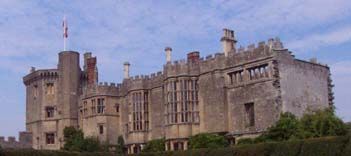 Thornbury Castle, which I call Tremayne Castle in my books.
Thornbury Castle, which I call Tremayne Castle in my books.
Dark is falling already, so we walk the grounds before the light disappears altogether, enjoying the quiet and the old, shadowed walls. Thornbury's grounds are large, and little is strictly in ruins, but since the castle was never completed, the area with livable rooms is smaller than one would expect. There were originally also timber buildings within the curtain wall, including a great hall, but the wooden portions are long gone.
Dinner at the castle can only be described as exquisite. It starts with
wines and little miniature appetizers in the library. Then we move to the
candlelit dining room for soup, a starter, main course, pre-dessert,
and then real dessert, too. We are waited on hand and foot, to the point
that we feel like we're the owners of the castle and everyone is there to
serve us. The meal takes two-and-a-half hours. As we make our way up to
bed afterward, we decide we could learn to live like this.
Saturday, August 16
Following a lovely breakfast, we start the morning with a tour of Thornbury Castle and learn more of its history. I ask about ghosts, but the gentleman showing us around seems reluctant to admit to any—we get the impression he's afraid of losing bookings.
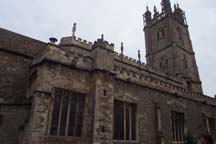 St. Mary the Virgin church, next to Thornbury Castle.
St. Mary the Virgin church, next to Thornbury Castle.
He shows us where there used to be a wooden bridge to St. Mary the Virgin Church on the other side of the castle wall, so after the tour we walk over to have a look. The church is old and impressive, and we can see where the bridge would have gone right over the graveyard with its ancient, weathered headstones.
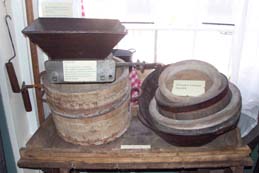 Cheesemaking equipment in the museum in Thornbury.
Cheesemaking equipment in the museum in Thornbury.
We drive into the town of Thornbury and head first for the little museum, where I learn cheesemaking has been a major industry there for centuries. There's a display on the methods and history—much useful information! Even so, the museum is so tiny it takes us less than half an hour to go through it.
Before we leave I buy some books (of course) and ask the way to the town's Information Centre. It has long been my habit to visit official Information Centres wherever I go, because I've found they usually have fascinating little books and pamphlets covering very local history and lore that it's impossible to find anywhere else. After raiding the Information Centre, we wander up and down Thornbury's High Street. It's quaint and charming, but a small town, after all, so it doesn't take us terribly long to complete our explorations.
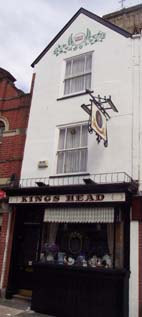 The King's Head, in Bristol, where my characters will stop for a meal.
The King's Head, in Bristol, where my characters will stop for a meal.
We drive half an hour south to Bristol. My characters will be traveling this road, and I hope to find a tavern in Bristol where they can stop for a meal. I'm in luck—there's one right on the main road, smack in the middle of the city—a tall, narrow, atmospheric pub built in 1660.
At the castle, we saw some beautiful Bristol Blue Glass,
so after
snapping pictures of the tavern and making some notes, we decide to visit
the factory. In a viewing gallery there, we watch the glass blowers at
work, and of course we each have to buy a piece before leaving. A
candlestick for me and a perfume bottle for Karen.
We've decided that Thornbury's lavish dinner two nights in a row would be
a bit beyond decadent, so we've booked high tea there instead. Since we
scheduled that for 4:45, we figure it will also do for dinner, but just in
case we get hungry later, we think we'd better stop and buy some snacks.
So before heading back home
to the castle, we stop at a Sainsbury's
supermarket in Bristol. They have an entire aisle (both sides!) just for
cakes and sugar.
We must buy some, of course. And some crisps
(potato chips) in all the flavors we can't get at home—Camembert and
cranberry, chicken tikka masala, Chinese spare ribs (yes, these are potato
chip flavors!), and more. We add some of our favorite British candy bars
to the basket and (in a paltry attempt to be healthy) each put together a
salad at the salad bar. By the time we're finished choosing goodies, we
have enough food and drink (not to mention calories) in our cart to last
several days.
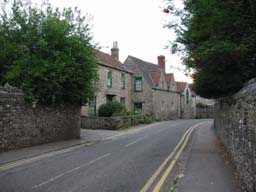 Street in the town of Thornbury.
Street in the town of Thornbury.
Back at the castle, high tea includes a huge platter of sandwiches plus
another huge platter of scones and cakes that could feed my whole family
and then some. Afterward, groaning with gluttony and thinking of all the
snacks waiting back in our room, we decide to take a walk. Leaving the
castle, we follow a town trail
that takes us through various cow
fields, past a graveyard, down to the town, and eventually back up to the
castle. We see a sweet kitten with unusual markings and decide that they
look like stained-glass windows—and that since my heroine is a
stained-glass artist, she must find and adopt this kitten in the story.
It's quite a hike, and afterward we decide that we deserve to sit and
enjoy the gardens.
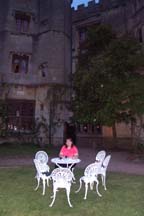 Karen in one of Thornbury's gardens.
Karen in one of Thornbury's gardens.
As we sip wine and watch the sun set, I imagine my characters here and picture some of the scenes. It is peaceful in the courtyard, with the last rays of the sun glinting off Thornbury's tall, beautiful oriel windows. We've been told that Henry VIII and Anne Boleyn trysted here…perhaps behind those unusual panes of curved glass?
History is full of so many possibilities.
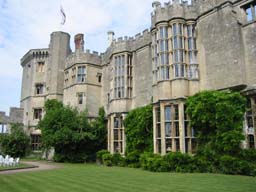 My heroine, who is a stained-glass artist, will be working on some of
these windows.
My heroine, who is a stained-glass artist, will be working on some of
these windows.
Sunday, August 17
This morning we begin following the path my characters will take when they journey from Thornbury back home. The first leg is a drive through Bristol to Bath, where they will stay overnight. Travel tip: if you go to Bath, obtain a city map before you leave. The city seems to be terribly short on directional signs. We drive around in circles for a good hour before we manage to find the historic part of town, and surely this cannot be our fault.
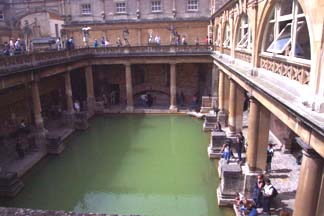 The Roman bath at Bath.
The Roman bath at Bath.
Having finally located the correct area and wedged the car into a toy-sized space in a claustrophobic parking structure, we begin by touring the Roman baths. My characters can't visit these baths, since they fell into ruin centuries before the time of my story in 1689, and remained buried and undiscovered until 1878. But the tour is fascinating, and once again we find ourselves amazed by the sophistication of life in Roman times. And the tour also includes the King's and Queen's Baths, built in medieval times and still open in the 17th century, so my characters can visit those.
After the tour, we stop at the Pump Room to try drinking water fresh from the underground springs. It costs 50 pence a glass and is hot (ick) and tastes of sulfur (double-ick) and other minerals. All in all, we decide it's not too terribly bad…but we don't finish the glass. Thankfully, we live in the 21st century, so no doctor has prescribed we drink a gallon a day as a cure!
In the town's Information Centre, I buy a map from 1723 showing how the town looked then and where all the inns were located. Eureka! We begin walking all the streets, hoping to find an inn that was also open 34 years earlier, in 1689. All over England, most historic buildings seem to have the year they were built posted somewhere on the front, and the people inside are frequently versed in the history of the place, so I am hopeful. But alas, my hopes are ultimately dashed. Though we tramp all over Bath, checking each of the twenty-odd inn sites, none of the inns still stand. They've all been replaced by buildings erected in Georgian times or later.
Oh, well…best intentions don't always work out. Although I won't be able to take pictures of a real inn my characters could have stayed at, I can still choose a location and use the real name of a real place that once stood there.
 The Westbury White Horse is the one on the hill, not the one in the
pasture! <grin>
The Westbury White Horse is the one on the hill, not the one in the
pasture! <grin>
We head out of town toward the next stop on my characters' journey,
Salisbury. On the way, we detour to see the Westbury White Horse, a huge
white chalk horse carved into a hillside. When we get to the parking lot
and gaze toward the site, we're amused to find a real live white horse
standing in the field directly before it. But the White Horse on the
hillside is a very modern-looking one, and, after snapping pictures, we
read the posted information and are disappointed to find it was created in
1778, modified in 1853, and restored in 1993. For some reason, we'd
thought all the White Horses were created in Druid times or sometime else
terribly ancient. Seeing a new
white horse isn't nearly as exciting.
Our hotel in Salisbury is the Red Lion Inn, built in the 12th century and called the White Bear Inn in the time of my story. My characters will stay here. Our room is small and old and crooked and beamed, and the adjoining bathroom is new and tiled and spotless. Perfect. But it's late, and we're tired, so we decide to leave the major exploring until the morning and head out for dinner instead.
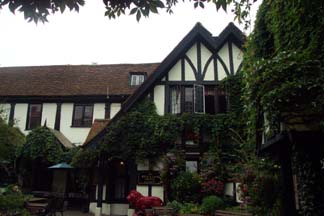 The Red Lion Inn, in Salisbury, which was called the White Bear Inn in
the year my characters will stay there.
The Red Lion Inn, in Salisbury, which was called the White Bear Inn in
the year my characters will stay there.
The hotel is in the center of town, near the old market square, where we find a nice, very modern Italian restaurant. After all the days we've spent immersed in history, it feels strange but good to be back in the 21st century for the time it takes us to eat dinner.
Afterward, we walk to Salisbury Cathedral and stand alone in the dark, silent close, admiring the medieval structure's towering spire (the tallest in England) and ancient, intricate walls. Lit up at night, the cathedral is awe-inspiring.
We'll visit for real in the morning.
Monday, August 18
We have much to do today, so we set the alarm for an ungodly hour and
begin by exploring the Red Lion Inn. A nice man at the front desk supplies
me with a printed history of the hotel, and I learn the building was
originally constructed to house the draftsmen working on the new
cathedral in the 1200s. When the basic construction was finished in the
late 13th century, the White Bear continued to house travelers
to the city and has done so ever since. Therefore, it is possibly the
longest running purpose-built hotel in the world.
The Red Lion is a popular hotel, but hardly anyone else is crazy enough to be up and about yet, so I'm able to snap some nice pictures that don't feature hordes of other tourists. We are especially taken with a beautifully carved medieval fireplace—so old the wood has turned black with age.
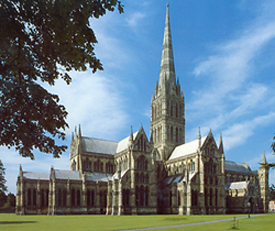 Salisbury Cathedral.
Salisbury Cathedral.
Afterward, we walk through the quiet streets to Salisbury Cathedral. The doors are open, but the only other people inside are a couple of caretakers sweeping the floors and someone practicing the organ (who, to our amusement, clearly needs the practice!). The soaring, vaulted ceiling towers anciently above us as we stroll, our footsteps echoing off the stone tombs honoring men who died seven hundred years ago.
Back outside the cathedral close, we stop in a small shop for tea and scones, then visit Salisbury's Information Centre. I've visited Salisbury before, so I already have all the guidebooks, but I have a scene in mind involving an old fountain, and I wonder if I might find one somewhere in the city. The gentleman behind the counter hems and haws, seemingly embarrassed that in this town surrounded by water, they have no fountains. He asks the rest of the staff, and they direct me toward Wilton House, a fifteen minute drive back in the direction we came from. There's a very elaborate old fountain there, they assure me, in front of the mansion house—I'll be able to see it through the gates without even paying the entrance fee.
We leave Salisbury and drive to Wilton House, but there's no old fountain visible through the gates, only a very new one. We park and go into the gift shop. The nice young woman at the ticket desk doesn't think there's an old fountain on the grounds, but she says the gardens are extensive and maybe she doesn't remember. She kindly invites us to walk the property and have a look—we can come back and pay, she says, if we find something worth staying to see. So we tramp around the acres of gardens…but find no fountain.
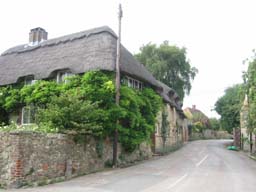 A street in the village of Amberley.
A street in the village of Amberley.
Oh, well, I'll just have to set the scene elsewhere. We return to our car and make the drive to Amberley. Since we can't check into our next hotel, Amberley Castle, until 3:00, we decide to explore the village first. It's absolutely charming, full of thatch-roofed stone houses lining winding, narrow lanes all perched on hilly land. But we can't find the High Street. We stop at a little pottery shop in one of the houses, and the woman there assures us the High Street is just down the lane and off to the left…but we still can't find it. We see one very old pub, and a sign directing the reader down an alley to a single store, but nothing else. Finally we give up and decide to go on to the castle even though we're still half an hour early.
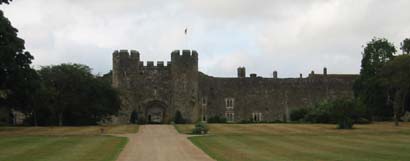 Amberley Castle.
Amberley Castle.
Amberley Castle, the inspiration for Greystone Castle in my books, is as
charming as I remember it. I'm so happy to be back. I never did research
it well—or the area surrounding it, either—because my last
visit was as a tourist, not an author, a good eight years before I even
thought of writing a book. I am thrilled with my pillow
present
—a gift-wrapped copy of a new hardback book all about
Amberley Castle's 900-year history. Our room is full of old, crooked
beams, and the bathroom is luxurious, with gold fixtures and a jacuzzi
tub. We ask where to find the High Street and learn we can take a path
from the castle, a five minute walk. We're told to go into the village,
past the pottery shop, and turn left to the High Street…which
consists of one pub and one general store. So we had found it, after
all! We decide to walk back, hoping the store also serves as an
Information Centre.
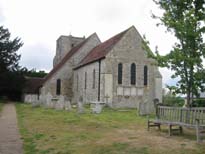 12th century church in the village of Amberley.
12th century church in the village of Amberley.
 Windows my heroine will have made.
Windows my heroine will have made.
The walk back to the village is picturesque and pleasant, past horses and goats and llamas (!) along a winding path. The general store doesn't house the Information Centre I was looking for, but signs direct us to the small 12th century church. Here we find booklets about the church and village (no one's there to take my money, so I just leave it in the donation box) and a lovely, ancient sanctuary with stunning stained glass windows, one of which is so perfect I decide that my heroine, the stained-glass window artist, must have made it. This would be her village church, after all.
We return to the castle and explore it, wandering the public rooms, snapping photos, then ambling around the grounds. Amberley is a small castle, less than half the size of Thornbury but at least ten times as charming. Much of it is in ruins (destroyed by Cromwell in the Civil War), and lovely gardens hide between the remaining walls.
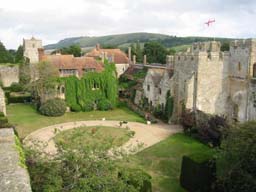 Amberley Castle from the wall walk.
Amberley Castle from the wall walk.
A high tower in one corner boasts a rickety wooden staircase leading to the wall walk, but I've a fear of heights and cannot bring myself to climb the wobbly steps. Karen braves them for me, describing the incredible views from up high and snapping pictures in all directions.
We change for dinner and then sit for a while on a terrace that used to be a kitchen projecting outside the castle walls. The view is tremendous, overlooking fields and forest. White doves and peacocks are there to entertain us, but after a while we decide to go in for dinner.
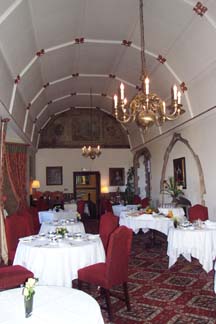 Amberley Castle's dining room.
Amberley Castle's dining room.
The grand dining room is upstairs and barrel-ceilinged—we're told
that more than three hundred years ago
it was open space, the top
half of a two-storied great hall that has long since been remodeled into
smaller rooms. A mural on the far wall dates from the 17th century,
honoring Charles II's restoration. The dinner consists of several courses,
very elegant and absolutely delicious. Afterward, I beg paper and pen from
the front desk, and we walk around the grounds, making notes of our
nighttime impressions while pretending that our quiet stroll will work off
the calories. We really didn't need those petit fours that came with the
tea after dessert…but we can diet at home, right?
Tuesday, August 19
Breakfast at Amberley is as elegant and delicious as dinner, though thankfully not so many courses. This will be our last day in England, but although we have much to do, we are loath to leave the castle. We decide to sit in the gardens a while—I type up yesterday's travelogue entry while Karen reads the morning paper. The weather is gorgeous—in fact, we can hardly believe we've been in England an entire week without being rained upon even once! After a while, Karen goes back inside to pack while I remain in the garden and continue typing. I wish I could stay here for days, sheltered by these ancient walls, doing nothing but writing (oh, and eating the lovely gourmet meals <grin>). Wouldn't it be fabulous to stay at the place a book is set while I'm writing it? Ah, well, a girl can dream…
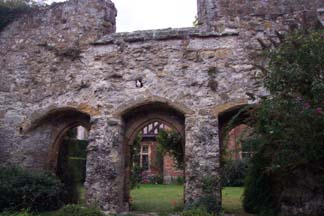 Part of Amberley's extensive gardens.
Part of Amberley's extensive gardens.
But alas, it is time to check out and relinquish our room to some other lucky people. Before going up, I take a few minutes to walk the grounds again in solitude, admiring the lovely flowers, the doves and peacocks, and the Tudor manor house tucked safe inside the crenelated walls, its own walls covered with ivy, its diamond-paned windows glinting in the late-morning sunshine.
It is so easy to imagine my characters living here, enjoying this place of their own, such a contrast from bustling, dirty, noisy 17th century London. I think Amberley Castle must be one of the most beautiful and peaceful places on Earth.
After checking out (sigh), we drive north to Windsor. Karen has never seen Windsor Castle, and I wish to visit because they are hosting a special exhibit about coronations. After a quick lunch in Eton, we walk over the bridge and duck into Sir Christopher Wren's House Hotel so that Karen can have a wee peek, since I used it in my book Rose as Kit Martyn's house. Then we go on up the hill to the castle, the largest in the world and a Royal residence for over 900 years. Much of its 800-plus rooms are inaccessible, since they're used by the current government, but the State Rooms are magnificent. I especially enjoy visiting the King's Dining Room again, since I had Kit building it in Rose.
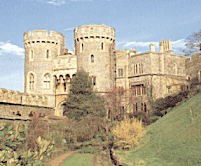 Windsor Castle.
Windsor Castle.
The coronation exhibit includes 17th century engravings from the time of the story I'm currently writing, showing William and Mary's coronation and the banquet afterward in Westminster Hall. Perfect! Karen is very patient while I make lots of notes. Sadly, I am not allowed to take photos, but I write down the names of the artists and the titles of the pictures. Maybe I can find copies online or in a book.
Speaking of books, I have bought entirely too many on this trip (as usual). There is no way they will all fit in the suitcase I brought, so I bought another suitcase in a shop in Salisbury…but books are heavy…so now I am wondering (dreading?) how I will be able to wrestle two crammed suitcases (plus my carry-on bag) to the airport by myself. But I don't have to worry about that yet. Our friends Andrew, Libby, and Jane have driven to Windsor to meet us for our final dinner, so we relax with the food, wine, and company until the hour grows late.
Since Karen has to be at the airport by 5:30 in the morning, we've decided to forgo historic accommodations and spend this last night at a Holiday Inn at Heathrow Airport. However, there are three Holiday Inns at Heathrow Airport, and I believe Heathrow Airport may well be the most confusing spot on the planet. We drive around and around and around. We call the hotel and ask for directions, but it doesn't help. We stop at a gas station and ask for directions, but that doesn't help, either. Finally, we stop at a hotel (not ours) and the concierge there is able to point us in the right direction.
 The remains of our supermarket feast.
The remains of our supermarket feast.
After checking in, we lug all our luggage (and all my books) upstairs to our room, not without difficulty, reminding me that I have to do this by myself in the morning. Thankfully, we have little trouble returning the car or catching a taxi back. It is well after midnight by the time we finally fall into bed, but we talk (and laugh) long into the night, feasting on the final remains of the supermarket snacks we bought days ago in Bristol, reluctant for our trip to be over.
Wednesday, August 20
I'm typing this on the plane home. Karen left our hotel room very early
this morning, and I left a couple of hours later. Happily, thanks to a
very kind driver on the Hoppa Bus
from the hotel to the airport,
I managed to get all my luggage (and books!) checked in without too much
trouble. Big, strong men really are very useful, aren't they? No wonder we
love reading about them in novels. <grin>
I'm looking forward to getting home to my family, but it's been a wonderful trip. And a very successful one. I've found everything I'd hoped to find for my story…well, except for a 17th century fountain. But there's always the Internet to find things like that…oh, and research books, too! Obviously I have plenty of those, so I'm not too worried…my characters are beckoning, and I am ready to write my story.









